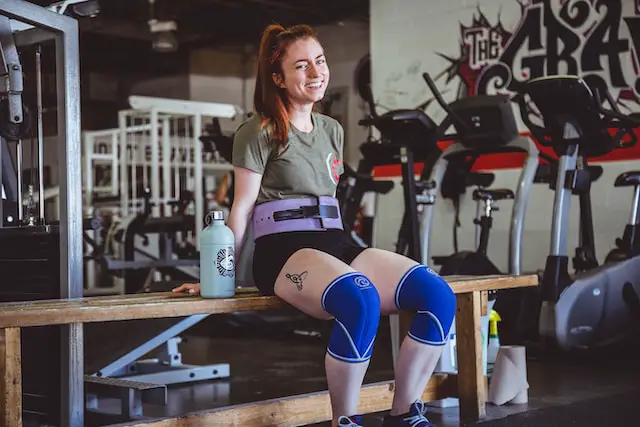Waist trainers have become increasingly popular in recent years, with many people using them to achieve a slimmer waistline. However, there is a growing debate about whether or not waist trainers are a good idea to wear while working out. Some people believe that wearing a waist trainer during exercise can help to increase sweat and burn more calories, while others argue that it can be dangerous and even harmful to the body.
Proponents of waist trainers argue that they can help to increase the intensity of a workout and target the abdominal muscles. They claim that the compression of the waist trainer forces the muscles to work harder, resulting in a more effective workout.
However, critics argue that this increased pressure can be harmful to the body, causing breathing difficulties and even damage to internal organs. Additionally, the excess sweating caused by wearing a waist trainer can lead to dehydration and other health complications.
Understanding Waist Trainers
Waist trainers, also known as waist cinchers, are garments designed to compress the midsection of the body. They are typically made of materials such as latex, spandex, or neoprene and are worn tightly around the waist. The idea behind waist trainers is that they can help to shape the waistline and create an hourglass figure.
While waist trainers have been popularized by celebrities and social media influencers, it is important to understand that they are not a magic solution for weight loss or body shaping. In fact, there is little scientific evidence to support the claims made by waist trainer manufacturers.
One of the main concerns with wearing waist trainers is that they can restrict breathing and cause discomfort. Waist trainers can also cause chafing, skin irritation, and even bruising or rib damage if worn too tightly or for extended periods of time.
It is important to note that waist trainers should never be worn during exercise, as they can interfere with proper breathing and increase the risk of injury.
Pros and Cons of Waist Trainers
Waist trainers have become increasingly popular in recent years as a way to achieve a slimmer waistline. However, there are both pros and cons to wearing waist trainers, especially while working out.
Pros
- Instant slimming effect: Waist trainers can instantly reduce the appearance of waist size by compressing the midsection. This can provide a boost of confidence for those who are self-conscious about their waistline.
- Posture improvement: Wearing a waist trainer can help improve posture by providing support to the back and core muscles. This can lead to a reduction in back pain and discomfort.
- Motivation: Some people find that wearing a waist trainer while working out can serve as motivation to stick to their fitness routine. Seeing the immediate slimming effect can provide a sense of accomplishment and encourage continued efforts.
Cons
- Breathing difficulties: Waist trainers can restrict breathing and cause shortness of breath, especially during exercise. This can be dangerous and lead to fainting or other health problems.
- Organ compression: Wearing a waist trainer can compress organs, leading to digestive issues and discomfort. This can also affect the function of the lungs and heart.
- Muscle weakness: Wearing a waist trainer can lead to muscle weakness and atrophy over time. This is because the trainer is doing the work of the core muscles, which can cause them to weaken and become less effective.
Waist Trainers and Workouts
Impact on Exercise Performance
Waist trainers have become increasingly popular among people who want to achieve a slimmer waistline. However, when it comes to working out, wearing a waist trainer can have a negative impact on exercise performance. The tight compression of the waist trainer can restrict breathing and limit the range of motion, making it difficult to perform certain exercises properly.
In addition, wearing a waist trainer during exercise can cause excessive sweating, which can lead to dehydration. This can be dangerous, especially during intense workouts or in hot and humid environments.
Dehydration can cause fatigue, dizziness, and even fainting, which can be dangerous when using heavy equipment or performing complex movements.
Effects on Body Shape
While waist trainers may provide a temporary slimming effect, they do not actually help to reduce body fat or reshape the body. In fact, wearing a waist trainer for extended periods of time can actually cause muscle weakness and atrophy, as well as damage to the internal organs.
Waist trainers can also create an unnatural and unrealistic body shape that can lead to body dysmorphia and other psychological issues. It is important to remember that everyone’s body is different and there is no one-size-fits-all solution to achieving a healthy and fit physique.
Health Risks Associated with Waist Trainers
Wearing waist trainers while working out may seem like a quick fix to achieve a slimmer waistline, but it comes with several health risks. Here are some of the risks associated with waist trainers:
Decreased Lung Capacity
Waist trainers compress the diaphragm, which can decrease lung capacity and make it difficult to breathe. This can lead to shortness of breath, dizziness, and even fainting during exercise.
Digestive Issues
Wearing waist trainers can also cause digestive issues such as acid reflux, heartburn, and constipation. The compression of the waist can also lead to bloating and gas.
Muscle Weakness
Waist trainers can weaken the core muscles, which are essential for maintaining good posture and balance. Over time, this can lead to muscle imbalances and increase the risk of back pain and injury.
Skin Irritation
The constant pressure of waist trainers against the skin can cause skin irritation and even lead to skin infections. This is especially true if the waist trainer is worn for long periods of time, such as during a workout.
Dehydration
Wearing a waist trainer can cause excessive sweating, which can lead to dehydration. This is especially dangerous during exercise when the body needs to stay hydrated to maintain optimal performance.
Expert Opinions on Waist Trainers
Waist trainers have become increasingly popular in recent years, with many people using them as a way to achieve a slimmer waistline. However, the question remains: are waist trainers a good idea to wear while working out? We’ve gathered the opinions of several fitness experts to help answer this question.
According to personal trainer and fitness expert, Jillian Michaels, “Waist trainers are a waste of time and money. They do not help you lose weight or burn fat. In fact, they can be dangerous as they restrict your breathing and can cause damage to your internal organs.”
Similarly, Dr. Holly Phillips, a medical contributor for CBS News, warns against the use of waist trainers. “Waist trainers can cause a number of health problems, including acid reflux, shortness of breath, and even fainting. They can also cause damage to your internal organs, including your liver and kidneys.”
On the other hand, some experts believe that waist trainers can be beneficial when used correctly. Personal trainer and fitness model, Massy Arias, advocates for the use of waist trainers during workouts. “Waist trainers can help you maintain good posture and can provide support for your lower back,” she says. “However, it is important to use them correctly and not to rely on them as a way to lose weight.”
Alternatives to Waist Trainers for Workouts
While waist trainers have gained popularity in recent years, many fitness experts do not recommend them for working out. Fortunately, there are several alternatives to waist trainers that can help you achieve your fitness goals without compromising your health.
Compression Shorts
Compression shorts are a great alternative to waist trainers. They provide support to your core muscles without restricting your breathing or movement. Compression shorts are made of breathable materials that wick away sweat, keeping you cool and comfortable during your workout.
High-Waisted Leggings
High-waisted leggings are another alternative to waist trainers. They provide support to your core muscles and help you maintain good posture during your workout. High-waisted leggings are made of stretchy materials that move with your body, allowing you to perform a wide range of exercises without restriction.
Waist Trimmer Belts
Waist trimmer belts are similar to waist trainers, but they are designed to be worn during workouts. They provide support to your core muscles and help you maintain good posture while exercising. Waist trimmer belts are made of breathable materials that wick away sweat, keeping you cool and comfortable during your workout.
Resistance Bands
Resistance bands are a great alternative to waist trainers for building core strength. They provide resistance to your muscles, helping you to tone and sculpt your abs, obliques, and lower back. Resistance bands are lightweight and portable, making them ideal for working out at home or on the go.
Conclusion
In conclusion, while waist trainers may provide a temporary slimming effect, they are not a good idea to wear while working out. The potential risks and negative effects on the body outweigh any potential benefits.
Wearing a waist trainer during exercise can restrict breathing and compress internal organs, leading to discomfort and potentially dangerous health consequences. It can also cause muscle weakness and poor posture, which can lead to injury over time.
Furthermore, there is no scientific evidence to support the claim that waist trainers help with weight loss or body shaping. Any perceived results are likely due to temporary water weight loss or compression of the waist area.
Overall, it is recommended to avoid wearing waist trainers while working out and instead focus on healthy eating and regular exercise for sustainable weight loss and body shaping.







